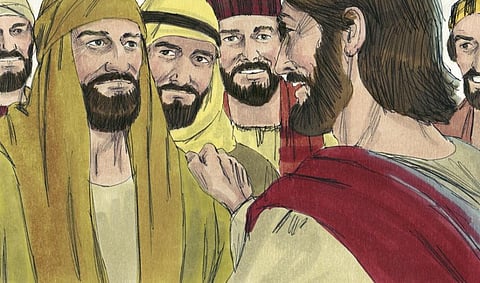A tale for Christmas: Here is why the Apostle Bartholomew is associated with agriculture in Goa
August is an important month in Goa. It is the time when the new rice grains (called konxeo in Konkani) are formed, according to an article published last year in O Heraldo. The festival celebrating the formation of new rice grains is called Konsachem.
The two main communities of Goa — Hindus and Catholics — celebrate the harvest in their own unique way. However, one tradition is shared by both. The first sheaves of rice, when harvested, are taken to be blessed: By deities in the case of Hindus. And by saints in the case of Catholics.
In the case of Goan Catholics, the festival reaches its peak on August 24, the Feast Day of Saint Bartholomew (also known as Nathaniel), one of the 12 Apostles of Jesus Christ.
Academic Rowena Robinson first described the Goan Catholic celebration of the harvest festival and its association with St Bartholomew in her 1995 paper Two Ritual Calendars in Southern Goa where she chronicled the agro-social similarities (and differences) between Goan Hindus and Catholics through a study of the mostly Catholic village of Santosgaon. She wrote:
The most important feast for the Catholics comes in August. This is the harvest festival which, in Santosgaon, is celebrated around the feast of St. Bartholomew on 24 August … In Santosgaon the feast begins with a procession to a field owned by the fabrica by the side of the church. In 1992, the procession was led by the parish priest and some gauncars. The priest ritually cut a few ears of grain and folded them in a white cloth. This was carried triumphantly into the church and placed on the altar. After the procession mass was said, and this took the form of a thanksgiving for a successful harvest. Some ears of grain were placed in the arms of the statue of St Bartholomew. Other offerings, of the flowers and vegetables of the season, were made during the mass.
India’s second Apostle
St Bartholomew is not the only saint whose blessings are sought by Catholics for the first grains of rice in Goa. As Robinson notes in Negotiating Traditions: Popular Christianity in India (2009):
The celebrations (of the harvest) are usually centred around the feast of a particular saint, which falls during the harvest season. These might be different for different villages. For instance, in the village studied by the author the feast is instituted in the name of Saint Bartholomew. However, other villages celebrate it in the name of Saint Lawrence (August 10), Saint Ignatius of Loyola (August 3) or on the day commemorating the Assumption of Our Lady (August 15).
Still, Bartholomew is special. Paul Fernandes, in a 2017 Times of India story, points to Bartholomew’s farming background as one possible reason as to why the tradition of cutting and blessing the first sheaves of rice came to be linked to the Apostle.
‘Bartholomew’ comes from the Aramaic (the language spoken by Christ) ‘bar-talmai’ or ‘son of the furrows’. According to the New Testament, the Apostle Philip introduced a skeptical Bartholomew to Jesus. His doubts, however, vanished on meeting the Great Teacher.
Fernandes notes that invoking Bartholomew’s blessings on Goa’s new rice is even more important, given that he is one of only two disciples of Christ — the other being Thomas — who came to India and preached the Christian faith.
It is indeed a fact not known to most. While the mission of Thomas the Apostle in present-day Kerala and Tamil Nadu is well-documented — earning him the title ‘Apostle of India’ — the mission of Bartholomew and its legacy seems to have been lost to time. But new research by historians and theologians has noted that the work of Bartholomew in establishing the Christian Church in India is equally important as Thomas’.
Works such as The two apostles of India by Spanish Jesuit Henry Heras (1944), Konkannachem Apostolik Kristanvponn (Konkani) by H O Msacarenhas (1960), The apostles in India by A C Perumalil (1971), East of the Euphrates: Early Christianity in Asia by T V Philip (1998) and Apostolic Christianity in Goa and in the West Coast by Cosme Jose Costa (2009), all highlight the connection between Bartholomew and India.
According to these books, Bartholomew landed at a place called Kallianpur on the north Karnataka coast in 55 AD (Thomas had landed in Muziris on the Kerala coast in 52 AD). He preached there and went further north, along the Konkan coast till the present-day city of Kalyan in the Mumbai Metropolitan Area. Kalyan was then a thriving port which had trade links with the Roman Empire and had a resident community of Jews, to whom Bartholomew first preached.
The TOI article notes that Bartholomew may have gone as far as Karachi on the coast of Sindh for missionary work.
The Apostle is generally regarded as having attained martyrdom in what is today Azerbaijan after he converted a local king and aroused the anger of the locals. He is said to have been skinned alive (flayed) and beheaded. Bartholomew, along with the Apostle Jude Thaddaeus, is said to have laid the foundation of the conversion of Armenia and Georgia in the Caucasus (near today’s Azerbaijan) to Christianity, the first countries to make it their national faith.
Heras, Mascarenhas, Perumalil, Philip and Costa, through their works, were able to show that Christianity in India had a pre-Portuguese origin and dated back to the Apostles of Christ. No wonder then, that St Bartholomew blessing the sheaves of rice in Goa has a special echo to it — Christianity is as Indian as any other faith of this land.


